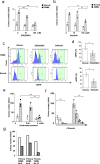Using patient-derived iPSCs to develop humanized mouse models for chronic myelomonocytic leukemia and therapeutic drug identification, including liposomal clodronate
- PMID: 30367142
- PMCID: PMC6203784
- DOI: 10.1038/s41598-018-34193-1
Using patient-derived iPSCs to develop humanized mouse models for chronic myelomonocytic leukemia and therapeutic drug identification, including liposomal clodronate
Abstract
Chronic myelomonocytic leukemia (CMML) is an entity of myelodysplastic syndrome/myeloproliferative neoplasm. Although CMML can be cured with allogeneic stem cell transplantation, its prognosis is generally very poor due to the limited efficacy of chemotherapy and to the patient's age, which is usually not eligible for transplantation. Comprehensive analysis of CMML pathophysiology and the development of therapeutic agents have been limited partly due to the lack of cell lines in CMML and the limited developments of mouse models. After successfully establishing patient's derived disease-specific induced pluripotent stem cells (iPSCs) derived from a patient with CMML, we utilized these CMML-iPSCs to achieve hematopoietic re-differentiation in vitro, created a humanized CMML mouse model via teratomas, and developed a drug-testing system. The clinical characteristics of CMML were recapitulated following hematopoietic re-differentiation in vitro and a humanized CMML mouse model in vivo. The drug-testing system using CMML-iPSCs identified a MEK inhibitor, a Ras inhibitor, and liposomal clodronate as potential drugs for treating CMML. Clodronate is a drug commonly used as a bisphosphonate for osteoporosis. In this study, the liposomalization of clodronate enhanced its effectiveness in these assays, suggesting that this variation of clodronate may be adopted as a repositioned drug for CMML therapy.
Conflict of interest statement
The authors declare no competing interests.
Figures





Similar articles
-
RAS mutations contribute to evolution of chronic myelomonocytic leukemia to the proliferative variant.Clin Cancer Res. 2010 Apr 15;16(8):2246-56. doi: 10.1158/1078-0432.CCR-09-2112. Epub 2010 Apr 6. Clin Cancer Res. 2010. PMID: 20371679
-
Effective drug treatment identified by in vivo screening in a transplantable patient-derived xenograft model of chronic myelomonocytic leukemia.Leukemia. 2020 Nov;34(11):2951-2963. doi: 10.1038/s41375-020-0929-3. Epub 2020 Jun 24. Leukemia. 2020. PMID: 32576961 Free PMC article.
-
Recent advances in diagnosis, molecular pathology and therapy of chronic myelomonocytic leukaemia.Br J Haematol. 2011 Apr;153(2):149-67. doi: 10.1111/j.1365-2141.2011.08631.x. Epub 2011 Mar 9. Br J Haematol. 2011. PMID: 21401573 Review.
-
Current management of patients with chronic myelomonocytic leukemia.Curr Opin Oncol. 2018 Nov;30(6):409-417. doi: 10.1097/CCO.0000000000000486. Curr Opin Oncol. 2018. PMID: 30169461 Review.
-
How I treat chronic myelomonocytic leukemia.Blood. 2017 Jul 13;130(2):126-136. doi: 10.1182/blood-2017-04-736421. Epub 2017 Jun 1. Blood. 2017. PMID: 28572287 Review.
Cited by
-
Mouse Models of CMML.Int J Mol Sci. 2021 Oct 26;22(21):11510. doi: 10.3390/ijms222111510. Int J Mol Sci. 2021. PMID: 34768940 Free PMC article. Review.
-
The Use of Stem Cell-Derived Organoids in Disease Modeling: An Update.Int J Mol Sci. 2021 Jul 17;22(14):7667. doi: 10.3390/ijms22147667. Int J Mol Sci. 2021. PMID: 34299287 Free PMC article. Review.
-
Harnessing the Power of Induced Pluripotent Stem Cells and Gene Editing Technology: Therapeutic Implications in Hematological Malignancies.Cells. 2021 Oct 9;10(10):2698. doi: 10.3390/cells10102698. Cells. 2021. PMID: 34685678 Free PMC article. Review.
-
Induced pluripotent stem cells in disease modelling and drug discovery.Nat Rev Genet. 2019 Jul;20(7):377-388. doi: 10.1038/s41576-019-0100-z. Nat Rev Genet. 2019. PMID: 30737492 Free PMC article. Review.
-
Induced Pluripotent Stem Cells as a Tool for Modeling Hematologic Disorders and as a Potential Source for Cell-Based Therapies.Cells. 2021 Nov 19;10(11):3250. doi: 10.3390/cells10113250. Cells. 2021. PMID: 34831472 Free PMC article. Review.

